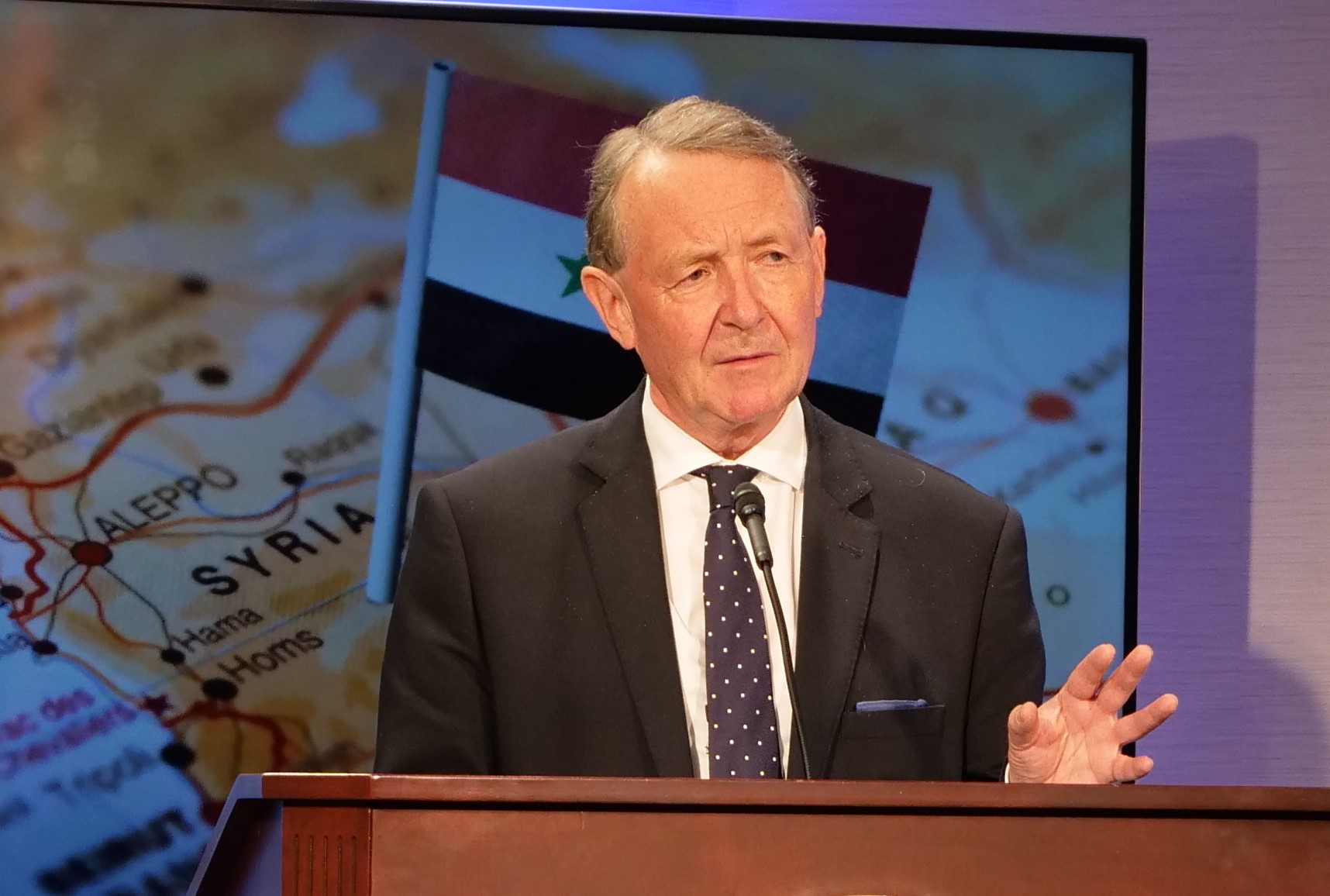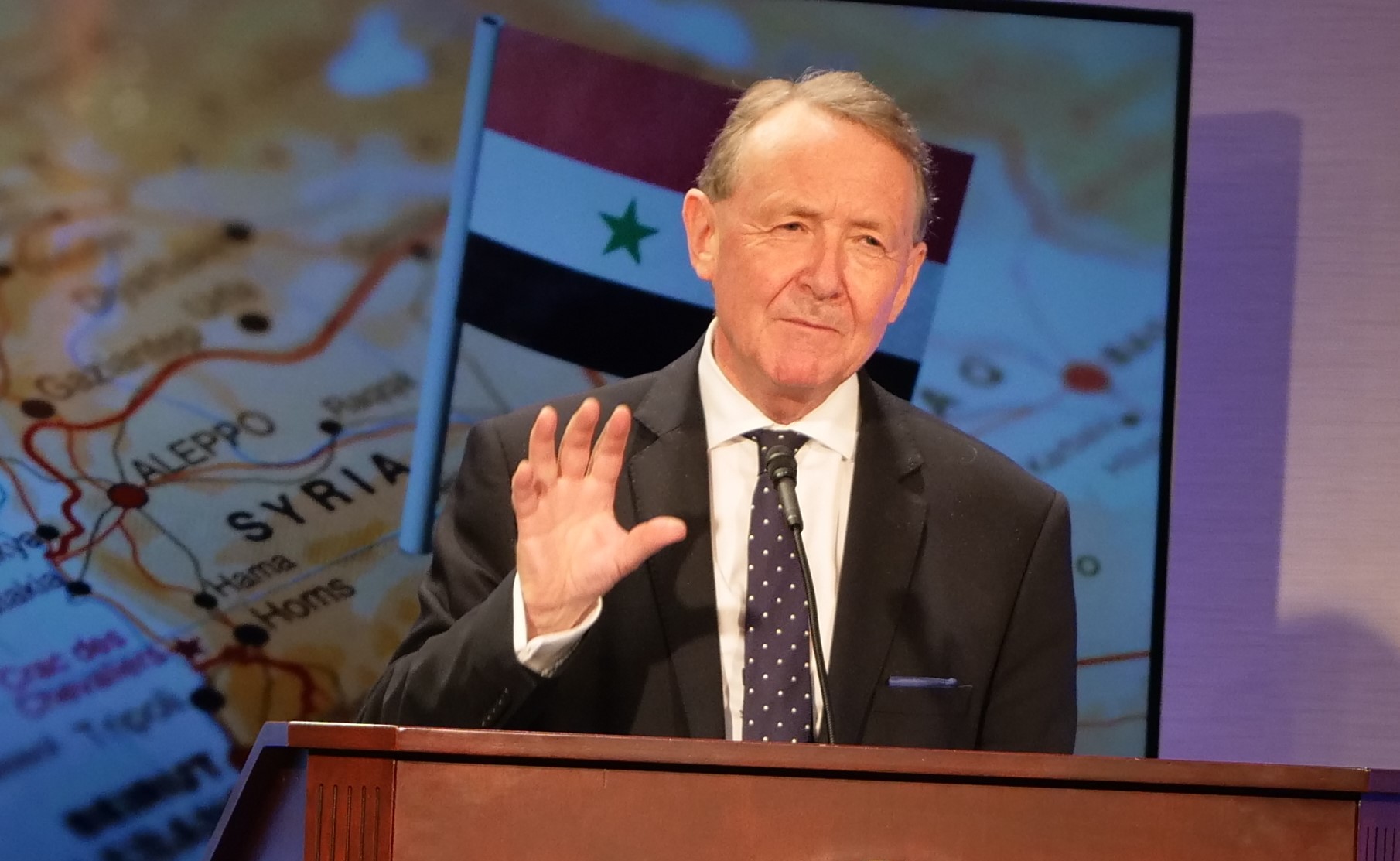Christian Holy Sites and Holy Places In The Middle East

(Extended version of) Remarks in Washington DC on July 18th 2019 by David Alton at a special conference on “Christian Holy Sites and Holy Places in the Middle East,” co-sponsored by the Hudson Institute’s Working Group on Christians and Religious Pluralism in the Middle East.
Prominent Middle Eastern Christian leaders – including the Greek Orthodox Patriarch of Jerusalem, were among the other speakers.
When , on his ‘pilgrimage of destruction’ , Tamerlane’s (Timur’s) Mongols invaded 13th Century Baghdad, they had been ordered to destroy thousands of that city’s books.
Michael Harris in his History of Libraries in the Western World says that in those days the River Tigris flowed black from the ink that was spilt, just as more recently rivers and roads have been drenched red from blood as ISIS have sought to go about their own reordering of the region’s minority communities and their cultures.
One thousand years ago the “mad caliph” of Cairo, Hakim, decreed that all churches, including the Holy Sepulchre in Jerusalem, the burial site of Jesus, should be torn down, razed to the ground.
And long ago , Nineveh had been laid waste by the Babylonians.
ISIS would simply like to complete what others had all failed to do.
Rivers running black and red. The dust and fires of destruction. Indifference to daily routines of forced marriage , beatings and abuse and rape. Genocidal assaults on a people are so often intertwined with attempts to wear down their confidence and to obliterate the sacred places and collections that embody them:
In Churches and holy sites, in religious cultural artefacts and the beauty of written and printed words memory and the present meet, lived lives and hopes for the future, days of joy and moments of sorrow , immense aesthetic beauty and the genius of great architecture, not to mention the physical ability to bring people together beyond bureaucracy and what many would see as a spiritual skill to provide a joining point between the earth and heaven itself.
These sacred places represent a fundamental part of our identity and psyche. Their obliteration has been part of an attempt by ISIS to eradicate more than history.
UNESCO lists 22 of the world’s 38 endangered cultural-heritage sites as being in the Middle East.
Think of Iraq’s and Syria’s churches and monasteries.
In June 2014, it was reported that ISIL elements had been instructed to destroy all churches in Mosul. The orgy of violence began in July when the Church of the Virgin Mary was destroyed with several improvised devices. Most other churches in the city suffered a similar fate.
In the same year ISIS destroyed the Tomb of Jonah – a site dating from the 8th century BC – and of great importance to Christians and many Muslims – but like the Sufi memorials n many other parts of the world unacceptable to the ISIS ideologues.
Later that year, 2014, Dair Mar Elia, the oldest monastery in Iraq, was demolished sometime between late August and September 2014 – unreported until 2016. St Markourkas Church, a 10th-century Chaldean Catholic church, was destroyed on 9 March 2015,and a nearby cemetery was also bulldozed. Others followed, like the Sa’a Qadima Church in Mosul, blown up in April 2016.
ISIS also blew up or demolished several other churches elsewhere in Iraq or in Syria. They included the Armenian Genocide Memorial Church in Deir-ez-Zor in Syria – built to memorialise and remember the1.5 million Armenians killed between 1915 and 1923. (The Deir Ez-zor became a yearly destination for pilgrims from around the world and gave the lie to Hitler’s boast “who now remembers the Armenians?”)
Destroyed too was the 7th century Green Church (also known as St Ahoadamah Church) in Tikrit belonging to the Assyrian Church of the East. In 2015 Isis destroyed the Mar Benham Monastery in Khidr Ilyas near Bakhdida in Iraq.
In 2015, on Easter Sunday, – a maliciously favourite day for their depredations and murders – ISIS destroyed the Assyrian Christian church of the Virgin Mary in the Syrian town of Tel Nasri. and then the historic monastery if St.Elian near Al-Qaryatayn in the Homs Governorate.
ISIS has also set fire to, or stolen collections of books and papers, such as those at Mosul’s Library – which they burnt-down and which was home to a Sunni Muslim library. Incinerated too were a 265-year-old Latin Church and Monastery of the Dominican Fathers, and the Mosul Museum Library. Some destroyed or stolen works date back to 5000 BC and at Palmyra – that classical oasis in the Syrian desert – they detonated and destroyed anything that might recall beliefs other than their own.
This is not just collateral damage from ‘war’. The stated goal is to destroy all non-Islamic books. The UN report that half of the old city of Mosul, in Iraq, and a third of the old city of Aleppo, in Syria, are reduced to rubble. No wonder Michael Danti of the American Schools of Oriental Research (ASOR) says “It’s Europe after the second world war’ .
And nor is it over.
As recently as Thursday 11 July, the Syriac Orthodox church of the Virgin Mary in Qamishli, in North East Syria, was targeted in a car bomb attack. Although there are no known fatalities, State media reported that 11 civilians were injured and that the church and nearby properties sustained material damage.
The attack on the church, which is in the predominantly Christian district of al-Wusta, occurred shortly before the end of the daily 5.30pm prayer service. It is assumed that Islamic State is behind the attack.
Qamishli is where, in June 2016, the Syriac Orthodox Patriarch survived an assassination attempt in which three others were killed.
Not in Syria, not in Iraq, not in Egypt – and not in African countries like Nigeria where ISIS affiliates have destroyed hundreds of churches – and not in atheistic Communist States, such as North Korea and China – where bulldozers have been demolishing churches. Not in any of these can be safety be assured.
This is more than a duty for the conservation sector. It is more than a human rights sideline. But how are we raising our voices as this obliteration of the sacred and enforced loss of memory and heritage occur?
The Harbingers We Ignored: Egypt’s Kristallnacht
In November 1938, in an orgy of violence which would become known as Kristallnacht, Jewish synagogues, homes, hospitals, and schools were ransacked and pillaged. The sledgehammers and petrol left more than 1,000 synagogues burnt and over 7,000 Jewish shops and businesses in ruins. The streets were covered in shards of smashed glass from broken windows.
A harbinger of the intentions of the Islamic militants became clear in 2013 when we witnessed the burning or bombing of more than 50 of Egypt’s churches schools, and homes.
Compare the charred husk of the Fasanenstrasse Synagogue in Berlin, in 1938, with pictures of the blackened walls of Degla’s ruined Church of the Virgin Mary and you will readily understand why after August 2013 I named it as Egypt’s Kristallnacht.
The comparison could be extended: Benchmark the terror of 1938 with the more recent fear of Copts, who constitute more than half of all Christians in the Middle East, as members of their community were left dead, others assaulted, and their 118th Pope, Tawadros II, put under protection having had death threats made against him.
In 1938 The Times commented that: “No foreign propagandist bent upon blackening Germany before the world could outdo the tale of burnings and beatings, of blackguardly assaults on defenceless and innocent people, which disgraced that country yesterday.”
In August 2013, in an almost identical vein, The Times reported how “Dozens of churches, homes and businesses have been set alight and looted in Egypt, forcing millions of Christians into hiding amid the worst bout of sectarian violence in the country’s modern history. Some Coptic Christian communities are being made to pay bribes as local Islamists exploit the turmoil by seeking to revive a seventh-century tax, called jizya, levied on non-Muslims.”
More than 90 churches, monasteries and church buildings were attacked across the country. The Times said there had been incitement, that Imams in the town of Fayoum reportedly urged supporters to go out and attack churches and Christians.
Come to think of it, that failure of religious solidarity could have been 1938 Germany or even 1994 Rwanda and Bosnia in 1995.
Copts: Their Favourite Prey
Just as the Nazis favoured the Jews above all else as their targets so have more recent events put the Copts at greatest risk. The Islamist genocidaires say that Egypt’s Copts are their “favourite prey”.
In Cairo, Franciscan nuns saw the cross over their school gate torn down and replaced by an al-Qaeda flag while the school was burnt down, and three nuns were frog marched through the streets while mobs showered them with abuse. One nun said, “They paraded us like prisoners of war.”
Joe Stork, acting Middle East Director at Human Rights Watch reported that “Dozens of churches are smouldering ruins, and Christians throughout the country are hiding in their homes, afraid for their very lives”
One of those who died during Egypt’s Kristallnacht was a young Christian deacon, Wahid Jacob, who had served the St.John the Baptist Church in Asyut until he was kidnapped. His captors demanded 1.2 million Egyptian pounds ($171,000) – an impossible ransom for his impoverished family. Their inability to pay up led to his execution. The priest who conducted Wahid’s funeral said that the young man’s body, found dumped in a field, was badly tortured.
When it comes to the Christian Copts the perpetrators enjoy impunity and terrorised at leisure. The Economist reported that “nowhere had the police thought to reinforce security, and nowhere did they intervene promptly or with sufficient force.”
The former Chief Rabbi of the Commonwealth , himself close to so many survivors of the Holocaust observed that the experience of the Copts was “a tragedy going almost unremarked” and is the “religious equivalent of ethnic cleansing”.
This side of Kristallnacht , Bosnia, Rwanda and Darfur we need to ask ourselves and our government what we said and what we did when they burnt the churches, terrorised the people and killed the Copts.
There has been some welcome change in Egypt. But Westerners should understand that what passes for democracy isn’t merely the holding of an election – like the one which ushered in the Third Reich after Kristallnacht. It is not the only test of what makes for a decent society. The rule of law is the first test and the protection of a country’s minorities and women, is the second.
Plurality and Diversity In The Middle East’s Future
Above all, the Middle East’s future will depend on the rule of law. There can be no peace or stability in Egypt or anywhere else in the region if the authorities fail to intervene to prevent the attacks or to bring the perpetrators to justice, or if they ignore the violent rhetoric which whips up hatred.
In a climate of fear and intimidation, coupled with historic and long-standing discrimination, the exodus of Christians from the region is entirely understandable. But if this represents the only future for the Christians of the Middle East it will be a tragedy for Egypt, Syria and Iraq – and for their Muslim neighbours. A Middle East which is unable to accept difference and unwilling to promote tolerance will be an increasingly unbearable place for all its other citizens.
That’s why the Christian Kristallnacht – the destruction of the holy places and sites, the memory and the story of who we are, matters so much. Because as our history is assaulted we need to gather up the prophetic fragments that remain, to help rebuild with ‘the Living Stomes’ who are left to us.
The Living Stones
But let me end by returning to the plight of “the living stones”
We know that up to 1,000 Christians are studying at Mosul University and commute daily from the nearby Nineveh plains, where it is said that that 9,130 families – 46 percent of the 2014 total – are now back. Some travel in from far away Dohuk and that hundreds more are employed to work there.
Father Emanuel Adel Kloo, the only priest in Mosul, said most of the faithful are still too afraid to return to the city whose Christian roots date back 1,800 years or more. Before ISIS laid siege to Mosul in 2014, 15,000 Christians lived there but he has hopes to restore a church complex there that would encourage more Christians to return to the city.
Describing his mission in Mosul as to “serve beneath the Cross”, the priest said that the reconstruction of the Church of the Annunciation – one of the first churches to be repaired since ISIS capitulated– was an important sign for Christians in the city.
The Syriac Catholic priest told Aid to the Church in Need that: “We hope that the church will be open in three months [and] that when it opens a lot of people will come.
“We still need other things to help people come back – we need a school, we need a housing complex for people who are poor and don’t have enough money to rebuild their own houses. I am hopeful that hundreds of people will return.”
He said it was very difficult to encourage people to believe in a future for Christians in Mosul.
And another small but welcome initiative was the launch of CREID The Coalition for Religious Equality and Inclusive Development which will be doing a lot of work in Iraq.
Professor Mariz Tadros of the Institute of Development Studies at the University of Sussex is its Director and tells me that they will try to build the capacity of young people from all religious minorities attempting to capture to undertake joint initiatives together. With support from the British Council a sister project will assist with the recording of the oral history of their communities, in particular those advanced in years, and how to digitise and preserving and disseminating these accounts for generations to come.
These are living stones, new foundation pieces, that will enable old histories to reignite the resilience of the most ancient of peoples, monuments and cultures.
Holding The Perpetrators To Account
Back on the 23 July 2014, I warned in an opinion piece in the Times:
“The last Christian has been expelled from Mosul … The light of religious freedom, along with the entire Christian presence, has been extinguished in the Bible’s ‘great city of Nineveh’ … This follows the uncompromising ultimatum by the jihadists of Isis to convert or die”.
I said that,
“the world must wake up urgently to the plight of the ancient churches throughout the region who are faced with the threat of mass murder and mass displacement”.
But the world chose not to wake up and for those caught up in these barbaric events, the stakes are utterly existential, catastrophic.
The Melkite Greek Catholic Archbishop of Aleppo, Jean-Clément Jeanbart, asked during a hearing I chaired at the British House of Lords:
“What are the great nations waiting for before they put a halt to these monstrosities? Let me cry with my people, violated and murdered. Allow me to stand by numerous families in Aleppo who are in mourning. Because of this ugly and barbarous war, they have lost so many loved ones, fathers, mothers, brothers and sisters and cherished children”.
As I have described ISIS has murdered, plundered, raped and abducted, including whole villages of Assyrian Christians. They have ripped buildings and great art and particular communities from the places in which they belong.
During a visit to a migrant centre in Greece, Pope Francis had the personal horror brought home to him when a Muslim man told him that he saw terrorists slit his wife’s throat when she refused to discard her crucifix.
He said that Christians had been subjected to genocide. The US, Uk and Australian parliaments have agreed.
On behalf of the then White House, Secretary of State, John Kerry, said:
“Naming these crimes is important”, and that Daesh, in targeting these minorities with the purpose of their annihilation, is “genocidal by self-proclamation, by ideology and by actions”— in what it says, what it believes and, indeed, what it does.
Today’s US Vice President, Mike Pence, has said the same.
But the Great Powers fear the consequences of those words. One can imagine Raphael Lemkin, the man whose often lonely campaign gave us the 1948
Convention on the Prevention and Punishment of the Crime of Genocide firing off letters to both Vice Presidents in frustration and fury.
With the Armenian disaster of 1915 , and KristallnachIt of 1938 in his mind Lemkin, recognised that “international co-operation” was needed, “to liberate mankind from such an odious scourge”.
Our failed policy towards Syria, thus far, has been to wish on it the same outcomes that we have seen in Iraq and Libya; failed policies that have been oblivious to the suffering and mayhem that has ensued.
The overall goal must be to enable all who have left, including Christians, to return to their homes, to be safe when they return, and to participate in rebuilding the region’s infrastructure and governance based on social and political equality, with religious freedom and human rights being safeguarded. This means healthcare and social support for people, fresh justice to bring perpetrators locally to account and new investment to restore the communities so aggressively targeted.
The Iraqi Archbishop of Erbil, the Rt. Rev. Basha Warda is right when he points out the British Government – and other donor countries – have been ‘“generous with your taxes when it comes to rebuilding Iraq. Unfortunately, everything they give is sent to the UN or other third-party NGOs”’, but‘“to date, not one single penny of it, and not one single penny from the EU or the USA or any other major donor, has been offered to the schools, university or hospital of my arch-diocese. I cannot say where it goes, but most assuredly it is not seen in any of the projects that have the greatest chance of bringing diverse Iraqi groups together in peace.”’
He asked: ‘“Will a peaceful and innocent people be allowed to be persecuted and eliminated because of their faith? And, for the sake of not wanting to speak the truth to the persecutors, will the world be complicit in our elimination?”’
Our aid programmes have been failing these beleaguered communities. So have our security policies. So has our unwillingness to create mechanisms to hold perpetrators of genocide to account. But one of the greatest failures of all has been the failure to assist in the rebuilding of every church and monastery and the restoration of every sacred site.
Such restoration and restitution will be the best guarantor of diversity and plurality, the best manifestation of Article 18 obligations to Freedom of Religion or Belief and, the best way we can ensure that those who would see the rivers run red with blood and black with ink while the dust and fires of destruction of people and great historical sites dominate the skyline have their own lamentable violence wiped away.
For while Tamurlane and his modern manifestations may have wanted a ‘pilgrimage of destruction’ we now have the task of building a journey of hope from international action globally and the living stones that still remain scattered across the region – and in this room today.
Also see: Speech to the Ministerial
https://www.youtube.com/watch?v=KsgWzQ2jTxw&feature=youtu.be&t=4344
Will Religious Freedom Survive in Northeast Syria?
https://www.frc.org/events/will-religious-freedom-survive-in-northeast-syria
July 16, 2019 18:00 ET
In the wake of the Syria civil war, Northeast Syria has developed into a semiautonomous zone with a surprising degree of religious freedom for the Middle East. Compared to elsewhere in the region, the Self-Administration of North and East Syria is an anomaly. Its government values religious freedom in a manner similar to the United States, enabling Christians, Yazidis, and other religious and ethnic minorities to prosper. A social compact provides equal treatment under the law for different ethnic and religious groups, enabling freedom to begin to flourish in a region often bereft of it.


